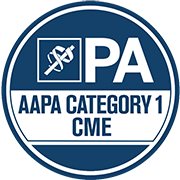WMJ Vol 121 Issue 1: Current Practice and Rationale of Prescribing Dexamethasone for Pediatric Patients Hospitalized for Asthma
ABSTRACT
Background: Croup (viral laryngotracheitis) is a respiratory illness that often affects infants and young children.
Objectives: Dexamethasone use for pediatric asthma exacerbations in the emergency department is supported in literature as a beneficial alternative to prednisone; however, there is limited data in the hospital setting. This study assesses factors that influence pediatric hospital providers’ steroid choice for patients hospitalized for status asthmaticus.
Methods: A survey was developed to assess factors influencing steroid prescribing practices. It was completed by our institution’s pediatric hospitalists and advance practice providers in June 2019 and April 2021. Responses were summarized using descriptive statistics, interrater agreement was analyzed with Cohen’s kappa statistic, and bivariate comparisons were analyzed with chi-square tests.
Results: Thirty-six of 39 providers completed the survey in 2019; 31 of 43 completed it in 2021. They reported wide disagreement with the use of dexamethasone in both surveys (2019 vs 2021: 34% vs 55% in favor, 43% vs 35% neutral, 23% vs 9% opposing, P = 0.191). There was a self-reported increase in prescribing frequency of dexamethasone from 2019 to 2021 (P = 0.007). There was moderate agreement with prescribing dexamethasone for patients with poor oral tolerance or medication noncompliance (2019: κ = 0.485, P = 0.002; 2021: κ = 0.281, P = 0.048). There was moderate agreement with prescribing prednisone for patients with higher severity of baseline asthma or current exacerbation (2019: κ = 0.537, P < 0.001; 2021: κ = 0.500, P < 0.001). Length of the dexamethasone course did not influence prescribing practices (P > 0.05).
Conclusions: In our inpatient setting, prednisone is preferred for severe asthma cases, while dexamethasone is preferred for patients with poor oral tolerance or medication noncompliance. The length of the dexamethasone course did not influence providers’ steroid choice.
Intended Audience
The target audience for this journal-based activity is healthcare providers caring for the people and communities of Wisconsin and beyond.
Learning Objectives
As a result of this journal-based activity, learners, as members of the healthcare team, will be able to:
- Explain provider-related, patient-related, and institutional factors influencing providers’ steroid choice for pediatric patients hospitalized for asthma.
- Discuss the study results indicating that prednisone is preferred for severe asthma cases, and dexamethasone is preferred for patients with poor oral tolerance or medication noncompliance.
- Utilize available evidence when choosing between prednisone and dexamethasone for status asthmaticus treatment of pediatric patients.
FACULTY DISCLOSURE
It is the policy of the University of Wisconsin–Madison Interprofessional Continuing Education Partnership (ICEP) to identify, mitigate and disclose all relevant financial relationships with ineligible companies* held by the speakers/presenters, authors, planners, and other persons who may influence content of this accredited continuing education (CE). In addition, speakers, presenters and authors must disclose any planned discussion of unlabeled/unapproved uses of drugs or devices during their presentation.
For this accredited continuing education activity all relevant financial relationships have been mitigated and detailed disclosures are listed below.
| Name of Individual | Individual's Role in Activity | Financial Relationship Disclosure | Discussion of |
| Marianna Shershneva, MD, PhD | Accreditation Specialist | No relevant relationships with ineligible companies to disclose | No |
| Shelby Nelipovich | Author | No relevant relationships with ineligible companies to disclose | No |
| Kelsey Porada, MA | Author | No relevant relationships with ineligible companies to disclose | No |
| Sarah Vepraskas, MD | Author | No relevant relationships with ineligible companies to disclose | No |
| Paula Soung, MD | Author | No relevant relationships with ineligible companies to disclose | No |
| Erica Chou, MD | Author | No relevant relationships with ineligible companies to disclose | No |
| Barry J Pelz, MD | Reviewer | No relevant relationships with ineligible companies to disclose | No |
| Sarina Schrager, MD | Editor and Reviewer | No relevant relationships with ineligible companies to disclose | No |
| David Dwyer, PhD, RN, NE-BC | Reviewer | No relevant relationships with ineligible companies to disclose | No |
Laura Ozkan, PA | Reviewer | No relevant relationships with ineligible companies to disclose | No |
*Ineligible companies are those whose primary business is producing, marketing, selling, re-selling, or distributing healthcare products used by or on, patients.
The ACCME does not consider providers of clinical services directly to patients to be ineligible companies.
Accreditation
Accreditation Statement
 | In support of improving patient care, this activity has been planned and implemented by the University of Wisconsin–Madison ICEP and the Wisconsin Medical Journal. The University of Wisconsin–Madison ICEP is jointly accredited by the Accreditation Council for Continuing Medical Education (ACCME), the Accreditation Council for Pharmacy Education (ACPE), and the American Nurses Credentialing Center (ANCC), to provide continuing education for the healthcare team. |
Credit Designation Statements
American Medical Association (AMA)
The University of Wisconsin–Madison ICEP designates this journal-based CE activity for a maximum of 1.0 AMA PRA Category 1 Credit™. Physicians should claim only the credit commensurate with the extent of their participation in the activity.
American Nurses Credentialing Center (ANCC)
The University of Wisconsin–Madison ICEP designates this journal-based CE activity for a maximum of 1.0 ANCC contact hour.
AMERICAN ACADEMY OF PHYSICIAN ASSISTANTS (AAPA)
 | The University of Wisconsin–Madison ICEP has been authorized by the American Academy of PAs (AAPA) to award AAPA Category 1 CME credit for activities planned in accordance with AAPA CME Criteria. This activity is designated for 1.0 AAPA Category 1 CME credits. Approval is valid until 9/20/2023. PAs should only claim credit commensurate with the extent of their participation. |
Continuing Education Units
The University of Wisconsin–Madison ICEP, as a member of the University Professional & Continuing Education Association (UPCEA), authorizes this program for 0.1 continuing education units (CEUs) or 1 hour.
Available Credit
- 1.00 AAPA Category 1 CME
- 1.00 AMA PRA Category 1 Credit™
- 1.00 ANCC Contact Hours
- 1.00 University of Wisconsin–Madison Continuing Education Hours
- 1.00 Approved for AMA PRA Category 1 Credit™
Required Hardware/software
Free, current version of Chrome, Firefox, Safari, or Edge. Some older browsers and Microsoft Internet Explorer could produce error messages or not display the content correctly.
Free, current version of Adobe Acrobat Reader or other .pdf reader.

 Facebook
Facebook X
X LinkedIn
LinkedIn Forward
Forward